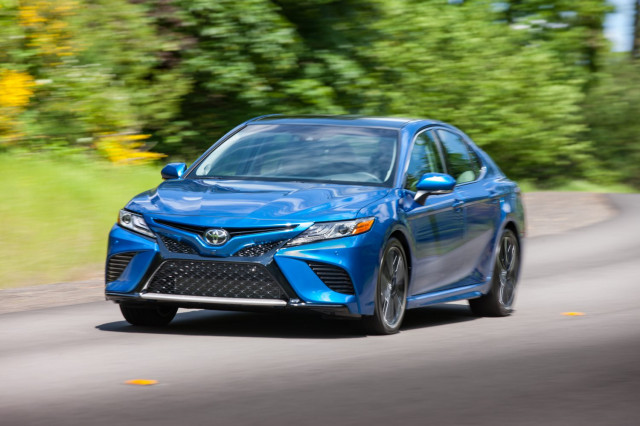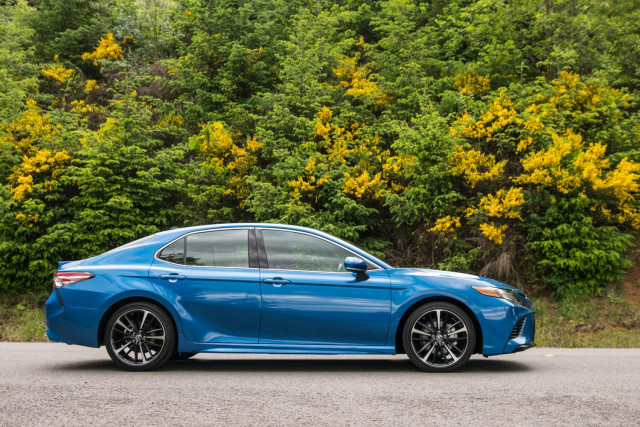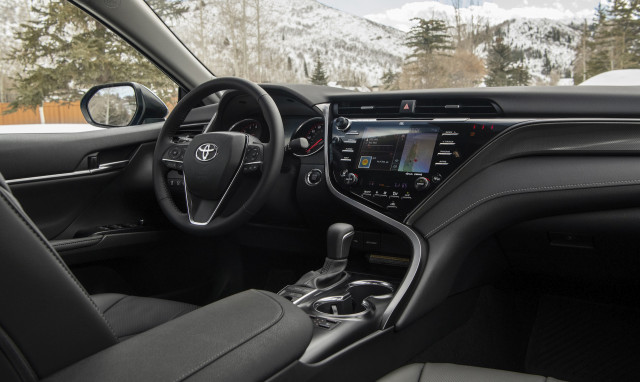
The 2020 Toyota Camry lineup ranges from mainstream suburban family car to hypermiling commuter to track-tuned TRD sports sedan. There’s something for everyone here, at least everyone who hasn’t followed the call of the SUV.
The base 2.5-liter inline-4 thrusts 203 horsepower to the front wheels, while the optional V-6 feels every bit stronger thanks to its 301-hp rating. The hybrid powertrain delivers performance akin to the base engine with fuel economy that can top 50 mpg, but only if you shop carefully and stick with the LE trim level.
Handling is gentle in base versions, somewhat short of thrilling in the tuned SE and XSE trims, and entertaining with the TRD badge affixed to the rear. Don’t look for all-wheel drive, something rivals have started to offer in a bid to lure SUV shoppers in wintry climes. All Camrys are front-wheel drive.
No matter what’s underhood, the Camry boasts a sleek shape that may turn off buyers looking for a conservative shape but works well to us. A driver-oriented dash inside gives the Camry a high-tech feel not entirely matched by its standard touchscreen, though new Android Auto compatibility this year joins Apple CarPlay to at least bring the sedan up to par. Interior space is good, but watch your head before ducking into the back seat. A surprisingly small trunk fuels the SUV fire.

Camrys have done exceptionally well in crash tests and boast a high degree of collision-avoidance features standard, as they should given prices that start around $26,000 and climb to $37,000 or more with options.
7
2020 Toyota Camry
Styling
The latest Toyota Camry cuts a stylish shape, something we’ve never said before.
The 2020 Toyota Camry tries hard to stand out, perhaps too much so from some angles, but we have to give its maker credit for the effort. We rate the 2020 Camry at 7 out of 10 for its styling.
All versions of the Camry share the same silhouette, whether they’re hubcap-clad Camry L sedans or the new rorty Camry TRD. The long nose and short tail give the sedan rear-drive-like proportions. Clean detailing helps, and versions with an S in their name -- SE and XSE -- as well as this year’s new TRD look the boldest of the bunch. Hybrids don’t look different other than their badges, which helps give them incognito eco-cred.
The Camry TRD is festooned with tuner-like lower cladding and a goofy rear spoiler. It’s the least-subtle Camry ever, though the bar wasn’t exactly high.
Inside, the sedans have a dashboard full of flair. It cants toward the driver, leaving the passenger feeling stranded. The standard 7.0-inch and optional 8.0-inch touchscreen sits high, with climate controls and storage bins below. Interior hues are low-risk grays and tans on most versions, though XSE and TRD versions can be had with bolder red and black trim.
2020 Toyota Camry
Performance
The 2020 Toyota Camry prioritizes comfort above all else in most trims, and that’s just fine with us.
Don’t let its sporty looks fool you: the 2020 Toyota Camry is a gentle performer in most configurations. That works well enough for us to elevate its score to 6 out of 10 based on its comfortable ride.
The 2020 Camry lineup consists of four basic flavors: standard L, LE, and XLE trims; sportier SE and XSE trims; hybrid versions; and the new Camry TRD.
The base 2.5-liter inline-4 shuttles 203 horsepower to the front wheels through an 8-speed automatic transmission. In most situations, the base engine provides more than adequate acceleration, though it can feel rough at lower speeds. The optional 3.5-liter V-6 makes the most of its impressive 301 hp sent forward again through an 8-speed automatic transmission. Passing power is superb with the V-6, which is only available in XSE and XLE trims.

Opt for the hybrid in LE, XSE, or XLE trims and Toyota swaps in a 176-hp version of the 2.5-liter inline-4 teamed with an electric motor that combines for 208 hp. Acceleration is on par with the base non-hybrid engine, and the powertrain works well with the electronic continuously variable
transmission (CVT).
Curiously, the base Camry Hybrid LE makes use of a lithium-ion battery, while the Hybrid XSE and XLE trims feature a heavy, lower-tech nickel-metal-hydride setup that’s less fuel-efficient.
Camrys with an L in their badges have a soft ride paired with light, accurate steering. They roll into corners when pushed, though they never feel sloppy. They’re cruisers, in Camry tradition. S and XSE version have a stiffer suspension and a lower ride height, as well as more steering heft. They’re not exactly sporty compared to, say, Toyota’s own 86 coupe, but they’re more entertaining than most mid-size sedans. Hybrids generally perform like their non-hybrid siblings, with a softer ride due in part to the extra heft of their batteries.
Camry TRD
The Camry TRD injects a little more fun into the package. Its 3.5-liter V-6 barks through a cat-back exhaust, and its buttoned-down suspension sits lower to the ground and utilizes stiffer dampers and beefier, solid sway bars. Body bracing stiffens up what was already a fairly beefy body shell.
Bigger brakes stop the Camry TRD better, while wider tires wrapped in available summer tires provide better grip.
The TRD is the Camry we’d buy as automotive enthusiasts, but it might not be the best choice for families due to its firmer ride and summer tires inappropriate for wintry or wet weather.
2020 Toyota Camry
Comfort & Quality
The 2020 Toyota Camry prioritizes form over function with a back seat that doesn’t impress.
The 2020 Toyota Camry has a spacious interior that offers good front-seat comfort, but rear-seat passengers will have to duck to climb aboard and still won’t find great outward vision. Overall, we rate the 2020 Camry at 6 out of 10 for its comfort. (Read more about how we rate cars.)
The front seats are firm and supportive on all versions. The base Camry L has manual front seats, while the LE adds power adjustability. Opt for leather upholstery and Toyota tosses in a power-adjustable passenger seat as well.
Rear-seat riders will have to duck to crawl in thanks to the car’s sloping roofline. Leg room is good for rear-seat riders, but the high window line means a constricted view out. Additionally, not all versions of the Camry have rear-seat air vents.

Most Camry sedans can lug 15.1 cubic feet of cargo in their trunks, an average figure for a mid-size sedan. Oddly, the base Camry L’s trunk measures just 14.1 cubic feet.
Interior storage space is decent, but not especially innovative against some rivals that seem to have a pocket for every size device or beverage imaginable.
All cars we’ve driven have shown good attention to assembly quality and have had mostly nice materials, though tech fabric on SE versions doesn’t feel especially rich.
2020 Toyota Camry
Features
The 2020 Toyota Camry comes in a wide array of trims and finally includes advanced support for Android devices.
Toyota offers a dozen versions of the 2020 Camry, meaning there’s one to suit just about every need and budget. From L to TRD, every 2020 Toyota Camry is well-equipped for the money, and we rate the lineup at a 7 out of 10 accordingly.
The base Camry L runs about $25,250, and covers the basics: a 7.0-inch touchscreen with Apple CarPlay and Android Auto compatibility, active safety tech, LED headlights, and power features. Most buyers will opt for the Camry LE that adds a power driver’s seat and alloy wheels for $550 more -- it’s money well spent, we say.
Full-boat Camrys come in two flavors: XSE and XLE, each with power-adjustable front seats wrapped in leather, JBL audio, keyless ignition, and more. This year’s new Camry TRD slots in below the “X” versions, making it an intriguing value for buyers focused on better handling.

Our pick? For commuting, we’d be just fine in a Camry Hybrid LE for about $29,200, though the Lexus-lite Camry XLE V6 with optional cooled seats, surround-view camera system, and more delivers luxury-grade features for a reasonable $37,200.
The base 7.0-inch touchscreen on most Camrys is adequate but not impressive. The larger 8.0-inch display is brighter and less prone to reflections, though still not as crisp as some competitors. Toyota’s baked-in software is light on flash, so it’s a good thing Apple CarPlay and Android Auto compatibility are now standard. Navigation is optional on high-trim models but not worth it unless you’re reluctant to plug your phone in.
Fuel Economy
The 2020 Toyota Camry is thrifty in most versions, and especially green as a hybrid.
Every version of the 2020 Toyota Camry is near the top of its segment when it comes to delivering good fuel economy, but you’ll want to shop carefully.
We rate the lineup at 6 out of 10, a score based on the 2.5-liter inline-4 used in most Camrys found on dealer lots. Hybrids -- especially the Camry Hybrid LE -- would rate higher
Wheel variations mean that Camrys with the inline-4 will have different fuel economy ratings depending on their trim level. The base Camry L is the thriftiest at 29 mpg city, 41 highway, 35 combined. The LE and SE knock that down to 28/39/32 mpg, while more bling means more gas in the XLE and XSE that are rated at 27/38/31 mpg.
V-6 version Camry XLEs are rated at 22/33/26 mpg (22/32/26 mpg for the XSE), which isn’t bad considering they pump out more than 300 hp. The Camry TRD’s aero kit doesn’t help fuel economy, which plummets to 22/31/25 mpg.
Want to save fuel while blending in? The Camry Hybrid LE delivers an inspired 51/53/52 mpg. The lower-tech battery in Hybrid XSE and XLE models drops ratings to just 44/47/46 mpg.


Comments
Post a Comment